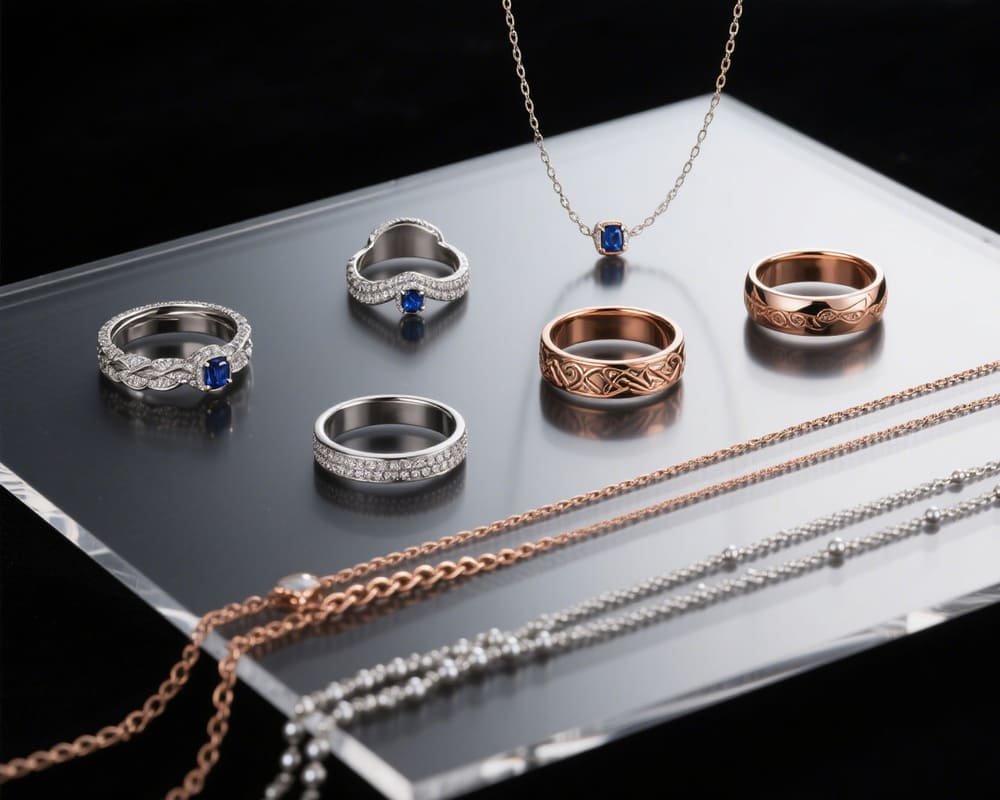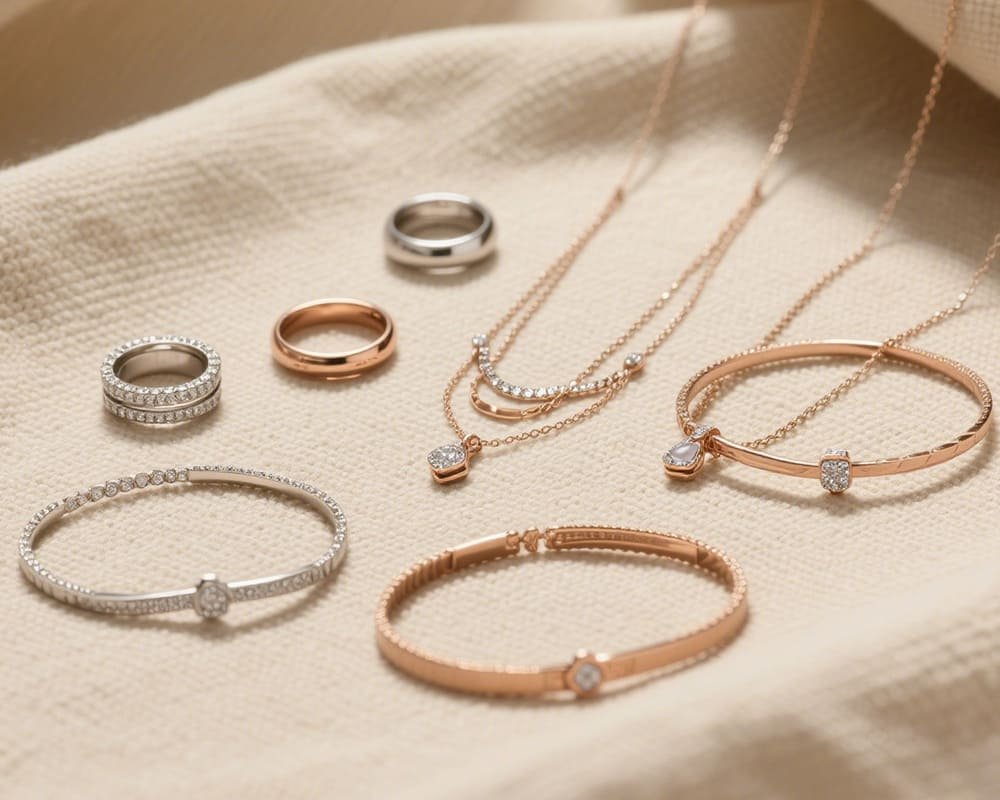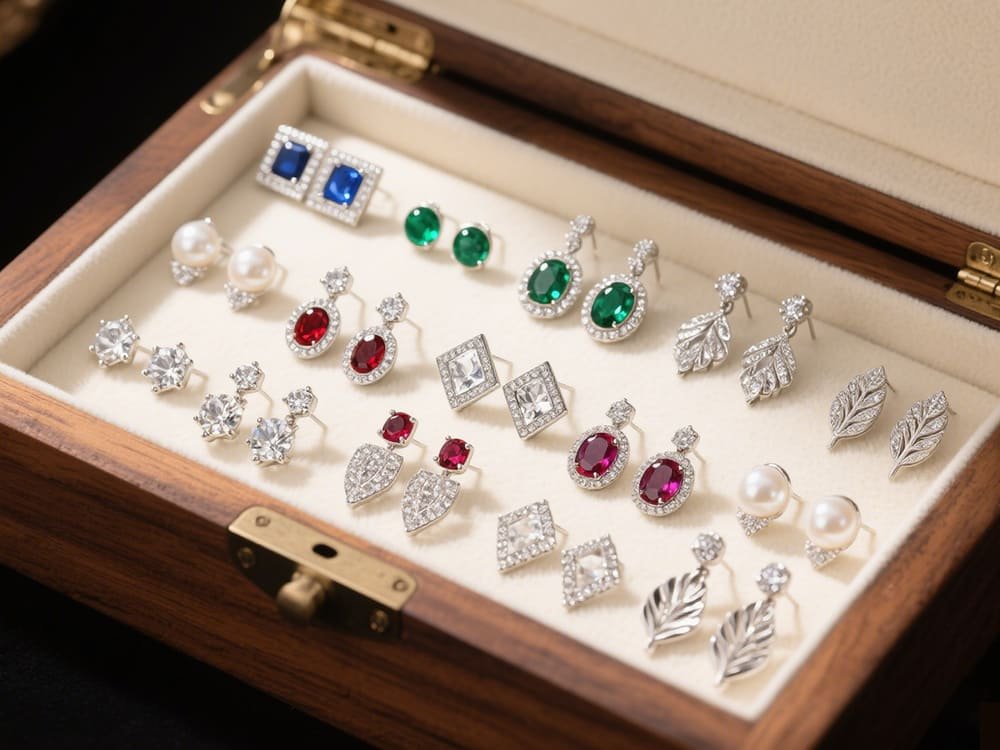Sterling silver, with its warm and brilliant light, has spanned thousands of years and is still our favorite choice for self-decoration. It is not as ostentatious as gold, but it has a unique elegance and affinity; it is not as rare and expensive as platinum, but it has won the hearts of countless designers and wearers with its pure luster and plasticity. Whether it is a unique design carefully crafted by an overseas jewelry manufacturer or a heirloom that carries special emotional significance, a piece of exquisite sterling silver jewelry deserves to be treated gently. However, we all have such a frustrating moment: opening the jewelry box, we find that our beloved silver necklace or bracelet has lost its former luster and is covered with an annoying black or yellow-brown color.
Don’t worry! This is not the end of the life of silver jewelry, but a reversible “chemical reaction show” between nature (mainly sulfides in the air) and precious metals. Oxidation and darkening are the natural properties of sterling silver (standard sterling silver is 92.5% silver + 7.5% copper alloy, copper is more reactive), and it is by no means a quality defect. Mastering the correct maintenance and cleaning knowledge is the magic key to restore the brilliance of your cherished silver jewelry anytime, anywhere. Fulcol jewelry China will take you to understand the secrets of silver jewelry discoloration, teach the most practical and safest daily care techniques and deep cleaning methods, and help you easily protect the pure silver light, so that every time you wear it, it will shine like the first time you fall in love.
Table of contents
Why does sterling silver jewelry turn black?
Are you curious about why seemingly stable silver “changes its temperament” and loses its luster? The core culprit is sulfidation, a special oxidation reaction:
Scientific essence: Pure silver (especially the silver in 925 Sterling Silver) reacts chemically with trace amounts of hydrogen sulfide (H2S) in the air to produce black silver sulfide (Ag2S). This reaction will proceed slowly even at very low concentrations of hydrogen sulfide.
Accelerating factors are everywhere:
Environmental pollutants: Industrial emissions, automobile exhaust (sulfur compounds), and air in hot spring areas (sulfur) can significantly accelerate the sulfidation process. A study cited by the U.S. Environmental Protection Agency shows that silver in urban environments can darken several times faster than in rural environments.
Daily contact objects: This is the most easily overlooked! Human sweat (sulfur amino acids and salts), skin care products (sulfur compounds, chlorides), cosmetics (pigments and chemicals), perfumes, hair sprays, household cleaners (bleach, ammonia and other strong oxidants or sulfur-containing substances), swimming pool water (chlorine), sea water (salt and sulfide), and even the gases released by certain foods (such as eggs and onions) can directly contact and corrode the silver surface.
Improper storage: Exposing silver jewelry to the air, or storing it in contact with materials such as rubber (sulfur), newspapers (ink contains sulfur), wool, etc., will continue to provide a source of sulfur and accelerate blackening. A humid environment makes things worse.
The role of copper: 925 sterling silver contains 7.5% copper to increase hardness. Copper is more easily oxidized than silver, forming copper oxide (CuO), which appears black or green, which is also one of the important reasons for the discoloration of silver jewelry.
“Oxidation” does not mean “damage”: It is important to remember that the silver sulfide layer is very thin, usually only a few microns deep on the surface of the jewelry. This means that the darkening is completely reversible! The right cleaning method can safely remove this layer of silver sulfide and restore the original luster of the metal without damaging the jewelry itself.

Golden rules for daily wear
Prevention is better than cure! Developing these small habits can greatly delay the darkening of silver jewelry and reduce the frequency of deep cleaning:
Rule 1: Wear it last and take it off first. Wait at least 15-30 minutes after applying makeup, spraying perfume, hairspray, and applying lotion/sunscreen for it to be completely absorbed and dry before wearing silver jewelry. Similarly, take off the jewelry as soon as you get home to avoid long-term effects of residues. This is the most important and effective habit!
Rule 2: Stay away from the “battlefield” of chemicals. Be sure to take off your silver jewelry when doing housework (contact with detergent, bleach, disinfectant), swimming (pool chlorine, sea salt and sulfur), taking a hot spring bath (high sulfur), and sweating a lot during exercise. The erosion rate of chemicals is much faster than you think.
Rule 3: Gentle wiping is a daily task. After each wear, gently wipe the surface of the jewelry with a microfiber jewelry cloth that you have given or purchased. This can wipe off sweat stains, grease and newly formed trace amounts of sulfide to keep it shiny.
Rule 4: Sweat is a gentle killer. In summer or after exercise, sweat a lot. After taking it off, first use a soft, moist (not soaked) cotton cloth (old T-shirt material can be used) to gently wipe off sweat stains, then wipe it dry with a dry cloth, and finally polish it with a jewelry cloth. Avoid sweat staying for a long time.
Rule 5: Store separately to avoid “mess”. It is best to have a separate small bag or soft cloth bag/separate jewelry box compartment for each silver jewelry. Absolutely avoid stacking multiple silver jewelry together or directly contacting and rubbing with other hard jewelry (diamonds, gemstones) to avoid scratching each other and accelerating chemical reactions.
Rule 6: Seal to isolate air and moisture. When not wearing, put the jewelry in an anti-oxidation bag or soft cloth bag into a jewelry box with good sealing. You can place high-efficiency discoloration inhibitors/anti-oxidation tablets in the box. These products form a protective layer on the surface of jewelry by releasing mild anti-corrosion gas molecules (VCI), effectively neutralizing sulfides.
Rule 7: Regular “physical examinations”. Even if you don’t wear it often, it is recommended to take out the jewelry every 1-2 months for inspection and wipe it with a jewelry cloth to ensure that there is no abnormal discoloration. Early detection and early treatment make cleaning easier.
Comprehensive cleaning strategy
When silver jewelry inevitably loses its luster, don’t panic! According to the degree of oxidation and the characteristics of the jewelry (whether it is inlaid, whether there is oxidation and aging process), choose the most appropriate method:
Mild oxidation: polish and instantly renew (for uniform light yellow or slight local blackening)
Professional silver polishing cloth
- Principle: Very fine polishing agent is woven into the cloth.
- Operation: Wrap the jewelry with a cloth and wipe the darkened area back and forth with a little force. The cloth will turn black, which is a normal phenomenon when the silver sulfide is wiped off. Keep wiping until the luster is restored. Applicable to all accessible smooth or simple patterned surfaces.
- Advantages: Fast, easy, safe, no need to wash, can be carried with you.
- Note: Silver polishing cloth has a lifespan (need to be replaced after becoming dirty or ineffective), and cannot be washed. Avoid using it on unsealed porous gemstones (such as turquoise, pearls, corals, opals, malachite, etc.), enamel, lacquerware surfaces or parts with deliberate oxidation and aging processes to avoid damaging the effect.
Wash with mild soapy water
- Applicable: Jewelry with no inlay or only inlay of water-resistant hard gemstones (diamonds, rubies, sapphires, crystals, etc.), and very slight oxidation.
- Steps:
- Dissolve a small amount of neutral detergent (such as dishwashing liquid, avoid strong alkalinity) in a bowl with warm water.
- Soak the jewelry for 2-3 minutes.
- Gently scrub the gaps and surfaces with an ultra-soft brush (such as a baby soft-bristled toothbrush or a special jewelry brush). Be gentle!
- Rinse thoroughly with running warm water to ensure that there is no residue.
- Pat dry with a lint-free microfiber cloth or paper towel, then wipe dry completely.
- Advantages: Better at cleaning dirt.
- Disadvantages: Limited effect on more obvious oxidation layers, water stains may remain if improperly handled or not dried thoroughly. Absolutely prohibited for use on organic gemstones (pearls, corals, amber, etc.), porous gemstones and glue-set jewelry.

Moderate oxidation: Efficient and precise application of silver cleaning solution (for uniform black or yellow-brown oxidation layers)
Principle: The main ingredients of silver cleaning solution are usually reducing agents such as sodium thiosulfate or acidic thiourea, which can quickly dissolve the silver sulfide layer and restore the metallic luster of silver.
Operation:
- Preparation: Use a plastic or glass container (non-metal). Make sure the jewelry is completely immersed in the solution.
- Soaking time: Usually only a few seconds to 1-2 minutes! Watch closely and remove as soon as it becomes bright. Overtime soaking can cause silver jewelry to turn white, lose texture or even corrode!
- Rinse thoroughly: Rinse the jewelry with plenty of running warm water for at least 30 seconds to ensure that all chemical residues are washed away.
- Dry completely: Dry thoroughly with a microfiber cloth and leave for a while to ensure complete drying.
Advantages: Fast speed, significant effect on uniform oxidation, and can handle gaps that silver polishing cloths cannot penetrate.
Disadvantages and risks:
- Highly corrosive: Never contact skin, eyes, or clothing. Wear gloves when operating and operate in a ventilated area.
- Risk of damage: It will corrode unsealed gemstones (especially porous, organic gemstones), enamel, lacquerware, other metals (such as K gold accessories), old oxide layers, and may cause loosening of the setting. Please be extremely cautious or avoid using gemstones (especially non-diamond/corundum) or special craft jewelry!
- Residual hazards: Incomplete rinsing will continue to corrode silver jewelry and irritate the skin.
- Not suitable for frequent use: Excessive use will slightly etch the surface of silver, making it more susceptible to oxidation and darkening again.
Severe oxidation/complex design: the power of professional tools
Electrolytic reduction method (professional/small household equipment):
- Principle: The oxidized silver (silver sulfide) is reduced to pure silver by electrochemical reaction. An electrolytic container, aluminum foil or aluminum plate (as anode), electrolyte solution (usually baking soda water or special salt), DC power supply (or special small machine) are required.
- Advantages: Very efficient, can handle severe oxidation without damaging the silver itself, especially suitable for jewelry with fine hollows and hard-to-wipe parts. Small household electrolysis machines are relatively easy and safe to operate.
- Disadvantages: Special equipment is required, there are risks for setting gemstones (especially porous and organic gemstones) (current and solution effects), and certain skills are required for operation. Be sure to strictly follow the instructions of the equipment.
Professional ultrasonic cleaning:
- Principle: The ultrasonic generator generates high-frequency vibration waves, forming countless tiny bubbles in the cleaning solution (cavitation effect), and the impact force generated by the bursting of bubbles peels off dirt and oxide layers.
- Advantages: Good cleaning effect for complex structures and gaps, relatively gentle physical method (depending on the solution).
- Disadvantages:
- Risk points: Vibration may loosen fragile inlays, cause gemstones (especially those with internal cracks) to break, damage porous organic gemstones (pearls, corals, etc. will peel off), dissolve glue (glue-set jewelry), and destroy oxidation aging process.
- Solution selection: A mild, neutral, and specially designed ultrasonic cleaning solution for jewelry must be used. Never use silver cleaning water or strong acid and alkali solutions!
- Recommendation: For jewelry with precious, complex or risky gemstones, it is strongly recommended to hand it over to a professional jeweler for ultrasonic cleaning with professional equipment and solutions, and clearly inform the jewelry material and inlay situation. Home ultrasonic machines need to be very careful in choosing solutions and modes.

The right way to store sterling silver jewelry
Even if you don’t wear sterling silver jewelry, you need to store it properly to avoid oxidation and blackening. The following are storage suggestions recommended by overseas jewelry manufacturers and professional retailers:
Store in sealed bags: such as ziplock bags or special antioxidant jewelry bags, which can block moisture and sulfides in the air.
Avoid mixing with other jewelry: especially metal jewelry with higher hardness such as stainless steel, brass, etc., to prevent scratching the surface of silver jewelry.
Store in a dry and cool place: avoid direct sunlight and high temperature and high humidity environment.
Can be placed in a moisture-proof bag or activated carbon bag: absorb moisture and reduce air humidity.
Check and wipe regularly: Even if you don’t wear it, it is recommended to check the condition of the silver jewelry once a month and wipe it properly for maintenance.
Good storage habits can keep your sterling silver jewelry as shiny as before after many years.
| Start Your Custom Order | Email: info@fulcol.com | Number: +86 13055603907 |
Choosing a sterling silver jewelry from a manufacturer that focuses on craftsmanship and quality lays a solid foundation for this beauty. Exquisite polishing, long-lasting rhodium plating, solid inlay and humanized design are silently reducing the difficulty of your maintenance and extending the shining cycle.
Every careful wipe and every proper storage is your commitment to this unique light. The value of silver jewelry lies not only in its stunning appearance when it first meets, but also in the warm story of being cherished and cared for that you give it over the years. When you are proficient in applying this knowledge and watching your beloved silver jewelry being reborn again and again in your hands, the sense of accomplishment and satisfaction is the best reward.
So, please start practicing with confidence! Let your sterling silver jewelry, whether new or old, shine with pure and warm light forever under your wisdom and care, crossing the long river of time, becoming a long-lasting elegant embellishment in your life, and even a brilliant story passed down from generation to generation. This shine comes from the nature of silver, and even from your heart.






